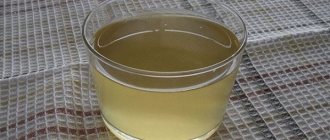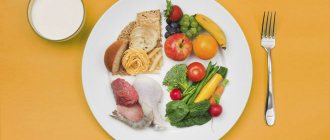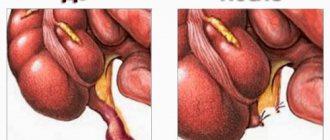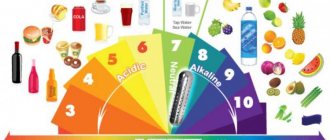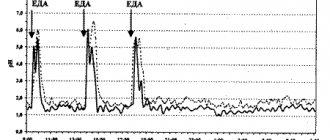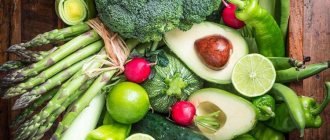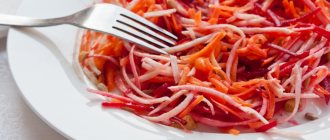It has long been known that food can both provoke disease and cure it. Pathology of the digestive organs is most often associated with poor nutrition. A timely transition to dietary meals in case of mild forms of disease allows you to prevent further development, protect damaged organs and restore their function without drugs.
A diet for heartburn helps to get rid of this painful symptom. In order to know which products to make up their diet, the patient needs to undergo a full examination, find out the diagnosis, and establish the cause of the painful manifestation.
What pathology is hidden behind heartburn?
Heartburn is a subjective feeling; each person describes it differently (“burns in the throat”, “burns behind the sternum”). It is caused by the backflow of stomach contents into the esophagus. Usually accompanied by belching and pain. At the bottom of the esophagus is the sphincter. Its task is to pass the bolus of food only into the stomach, then seal the passage hermetically.
The process is regulated by the nerve endings of the vagus and sympathetic nerves, the brain, and hormonal influences. It is the increased level of progesterone that explains temporary heartburn in a pregnant woman. Failure to close the sphincter allows stomach acid to enter the lining of the esophagus.
This is possible with a functional breakdown of regulation (one-time overeating of heavy food, stress, performing physically demanding work). In such conditions, a person notes the inconsistency of the symptom (“there was once heartburn and it went away on its own”). However, nutrition at the time of heartburn has its own characteristics. It is much worse if, over time, “burning in the esophagus” becomes a regular sign of the disease.
The most common heartburn observed:
- for diseases of the esophagus (esophagitis, achalasia, cicatricial narrowing, Barrett's esophagus);
- stomach pathologies (gastritis, peptic ulcer, tumor);
- diseases of the intestines and bile ducts;
- systemic connective tissue pathology (lupus erythematosus, scleroderma, amyloidosis);
- hiatal hernia;
- alcoholism;
- abdominal obesity.
Heartburn becomes a strong and constant symptom with gastroesophageal reflux disease. In addition to the impaired closure of the sphincter, an increase in intra-abdominal pressure (with constipation, lifting weights) is related to the occurrence of reverse expulsion of acid. We have provided detailed explanations to make it clear that the occurrence of heartburn does not necessarily correspond to a high level of acidity.
It may bother you when eating or after eating, on an empty stomach, at night, when the body is in an inclined position.
Additional signs are needed for an accurate diagnosis, so it is better to tell your doctor about them
How to identify and treat high acidity with folk remedies?
Poor nutrition often causes increased stomach acidity.
Increased stomach acidity, which causes various diseases, directly depends on the acidity of gastric juice, which directly depends on the hydrochloric acid it contains. The most acceptable percentage of this acid is 0.4-0.5%, and as soon as it slightly exceeds the norm, the first symptoms that determine acidity appear - heartburn and a burning sensation in the throat after eating sour food.
Moreover, if the content of hydrochloric acid is even higher, the patient begins to develop gastritis, and sometimes with serious complications, which leads to a deterioration in the functioning of the digestive system and the general condition of the gastrointestinal tract.
To prevent this, if heartburn recurs repeatedly, you need to consult a doctor, who will prescribe probing, through which you can find out the acidity of the juice.
But it is not necessary to wait for probing before starting to independently treat stomach pathology with the help of folk remedies and proper nutrition. An excellent remedy against high acidity is potato juice, which you should drink on an empty stomach every morning half an hour before breakfast. Treatment with this juice can be repeated for 10-14 days in a row, then wait a week and repeat the course again.
Peppermint tea is also an excellent remedy for high acidity, as it not only reduces stomach acidity, but also helps to calm the patient. Making it is as simple as regular tea - you just need to pour a teaspoon of finely chopped herbs into a glass of boiling water, leave the drink for 10-15 minutes, and then drink warm mint tea. Since mint is not only useful, but also completely safe, the duration of such treatment is unlimited and depends solely on the wishes of the patient.
Another way to reduce stomach acidity using folk methods is to consume an infusion of wormwood and yarrow. To prepare it, you just need to mix 4 teaspoons of wormwood and 1 teaspoon of yarrow, and then pour a glass of boiling water over the mixture. Then you need to let the infusion stand for 30 minutes, strain it and drink a tablespoon four times a day for 2 weeks. You can check the acidity of the stomach by probing and the presence of heartburn after each meal, and it can be cured with potato juice, mint tea and infusion of yarrow and wormwood.
Principles of nutrition for heartburn caused by functional disruptions
We offer rules of regime and nutrition, following which you can avoid unpleasant manifestations for people without pathology of the digestive organs. Eat regularly, avoiding long breaks and feelings of hunger. Those who are trying to lose weight on a fasting diet should remember that acid accumulates in the stomach, which sooner or later will lead to negative consequences.
Therapeutic fasting is carried out only in specialized clinics under the supervision of medical research. Avoid an abundance of fatty and fried meat foods, hot seasonings and sauces, cream cakes and sweets, especially in the evening. These dishes form “deposits” in the stomach, where they remain for 10–12 hours instead of the normal six hours.
Do not get carried away with alcohol, carbonated drinks, beer, coffee. They slow down the digestion process.
Exclude from the menu dishes and foods that increase gas formation (fresh bread, cabbage, mushrooms, beans and peas, grapes). Have dinner no later than 4 hours before bedtime. It is advisable to take a walk after dinner. The process of walking is a physiological stimulator of the stomach and intestines. Don't go to bed after lunch. Avoid lifting weights and bending your body.
Accustom yourself to sleep on a high pillow to make it difficult for contents to flow into the esophagus at night. Stop smoking; nicotine has a significant effect on the nervous regulation of the sphincter. Try to lose excess weight with the help of a balanced load and rational dietary restrictions. Take mineral waters 20–30 minutes before meals; the composition should be close to alkaline.
You should not wear tight belts, corsets, or tight trousers, as they help increase intra-abdominal pressure.
General information about cottage cheese
Cottage cheese is valued for its high taste and the benefits it brings to the body.
Nutritionists recommend including it in the diet of athletes, children, pregnant women and anyone who suffers from digestive disorders.
Compound
Product contains:
- vitamins of groups A, B, C, E;
- lactose;
- proteins;
- lactic acid bacteria;
- macro- and microelements.
Properties
Cottage cheese has a beneficial effect on the cardiovascular and nervous systems. It is recommended to be used for pathologies of the liver and kidneys. The product helps restore the gastric mucosa. Regular consumption of cottage cheese improves metabolism and relieves constipation.
Cottage cheese restores the gastric mucosa.
The protein contained in the product is absorbed by the body more easily than a similar component obtained from meat.
Cottage cheese is prescribed during illness to reduce the load on the body and at the same time give it the opportunity to receive the necessary vitamins.
Benefits for the body
Calcium is considered the most valuable component in fermented milk products. If the microelement enters the body in sufficient quantities, a person is less likely to experience caries. In old age, calcium becomes a protection against osteoporosis.
What to eat if heartburn is caused by illness?
Nutrition for heartburn caused by organic changes in the stomach and esophagus is based on the acute or chronic stage of the disease and the level of acidity. For inflammation of the esophagus and stomach, the same menu is selected. On the Pevsner scale, this is table number 1 with options. Maximum restrictions in the diet for heartburn are necessary for the erosive and ulcerative process.
Table rules No. 1
The main objective of the dietary option is to ensure maximum sparing of the mucous membrane of the esophagus and stomach, to help restore normal regulation of hydrochloric acid secretion and the functioning of the cardiac sphincter. General requirements include:
Diet for gastritis of the stomach
- creating maximum rest for inflamed tissues;
- exclusion of mechanical causes of irritation (meals are prepared pureed, liquid, fried foods are prohibited);
- providing protection from chemical and thermal irritants, if you have heartburn, you should not eat spicy foods, smoked meats, pickles, sauces, keep the food temperature during feeding within 38 degrees (excessively hot and cold foods are prohibited);
- elimination of long-term food retention due to overeating;
- increasing the frequency of feedings up to 5–6 times with decreasing portions.
Special requirements regarding diet for heartburn:
- products with juice properties are excluded;
- the amount of salt is limited to 10 g/day;
- maintaining sufficient calorie content, the required amount of nutrients, vitamins, and microelements.
Reviews and results
With heartburn, patients quickly identify the foods or dishes that cause it. Sometimes their exclusion saves patients forever from this unpleasant phenomenon. In more severe cases, when there are symptoms of esophagitis, the diet must be followed constantly and proper nutrition should become the norm of life. It turns out that it is not so difficult to exclude spices, fried foods and cook everything by steaming or in a slow cooker. By reviewing your diet, you can eliminate heartburn, belching and discomfort in the esophagus and stomach.
- “... I have been suffering from this for a long time, but periodically. I know exactly what foods I can’t eat, but sometimes I allow myself to eat them and then regret them. I think that this is not the norm and should not be like this, so I did a gastroscopy. They said that there is already inflammation of the esophagus and that I need to undergo a course of treatment and follow a diet until it goes away. I followed the diet for 2 months, felt good and thought that I had gotten rid of this unpleasant symptom forever. But when I started eating a little citrus fruits and pickled vegetables, everything came back, although not as pronounced. I came to the conclusion that I need to monitor my diet constantly, although it is very difficult to cook for myself separately, because the family will not eat unroasted soups all the time. With this diet I lost 5 kg”;
- “... Heartburn bothered me periodically, but for a long time. I didn’t attach any importance to this - I bought medicine at the pharmacy and didn’t follow a diet. But when pain appeared in the esophagus when food passed, I thought about it and decided to get examined - erosion was discovered. She was treated in gastroenterology, ate properly by the hour. I don’t think I could organize this for myself at home. The erosions healed after 15 days, I was discharged, but with the condition of continuing restorative treatment for 6 months and following a diet. I followed it for 3.5 months - I tried to chop it up, and then ate lumpy boiled meat, chicken and fish. I ate mostly soups and porridges (sometimes with milk). Of course, if you are on a diet, then nothing worries you. I noticed that my stomach didn’t hurt and my gallstones didn’t bother me. I feel good, I want to follow a diet constantly”;
- “... Heartburn tormented me - it happens after sweet and sour, spicy and fried foods. I noticed that over the years there are more and more foods and dishes that are poorly tolerated and need to be excluded. This finally forced me to be examined and thoroughly treated. She was treated at home and organized dietary meals. It was easy to do this, since I have a double boiler and a multicooker in my arsenal - you just need not to be lazy. Relief came after 7 days - lightness in the stomach, absence of belching and burning sensations in the throat. I noticed that I shouldn’t overeat, so I take several dishes to work (porridge, cottage cheese, steamed cutlets) and eat every 3 hours, then there is no sucking pain in the stomach, which happens with high acidity.”
What products are prohibited on the menu at table No. 1?
In accordance with the requirements for restrictions, table No. 1 recommends refusing:
- from butter and rye bread;
- broths and soups made from fatty meat or fish;
- dishes made from cabbage, mushrooms, tomatoes;
- fried and smoked fish, meat, lard;
- sausages;
- raw vegetables;
- greens, onions and garlic;
- hot seasonings, sauces, ketchup, marinades;
- any canned food, including juices;
- carbonated and soft drinks;
- fruits (especially citrus fruits);
- chocolate;
- ice cream;
- coffee and alcohol.
Contraindications apply to vegetables containing coarse fiber and essential oils (turnips, asparagus, radishes, garlic, legumes).
Berries and fruits with thick, rough skin are not recommended (currants, gooseberries, dates, apples, pears, figs)
Fully or partially limited products
For heartburn and gastritis, it is necessary to exclude:
- Fried foods, mushroom decoctions, stewed meat and fish - all these products contain large amounts of extractives.
- Pickled vegetables, garlic, onions, mushrooms, tomatoes, pickled fruits and vegetables.
- Citrus fruits, sour fruit juices, lemon juice - it is not acceptable even as a salad dressing.
- Products that increase gas formation: radishes, white cabbage, radishes, legumes, kvass, yeast baked goods, raw apples.
- Solid fats, lard, margarine, dishes with mayonnaise, heavy cream, goose and duck meat, fatty beef, lamb and pork.
- Canned food, smoked meats, meat and fish broths.
- Seasonings, spices, lemon juice, vinegar, hot sauces, mustard, ketchup, horseradish, tomato paste, all types of peppers.
- Pasta (pasta, cookies and buns), fresh bread, pastries and cakes.
- Chocolate, since it contains methylxanthine , which relaxes smooth muscles, strong tea, coffee, cola.
- Alcohol (any type, including beer).
- During an exacerbation - raw vegetables and fruits, nuts.
- Halva, sweet jam, sweets and other sweets, as they can cause heartburn, and the high content of quickly digestible carbohydrates leads to increased gas formation, which should be avoided in this pathology.
- Difficult to digest millet, pearl barley and barley cereals. Keep in mind that millet porridge itself can cause heartburn.
- Fermented milk drinks with high acidity.
Table of prohibited products
| Proteins, g | Fats, g | Carbohydrates, g | Calories, kcal | |
Vegetables and greens | ||||
| vegetables legumes | 9,1 | 1,6 | 27,0 | 168 |
| canned vegetables | 1,5 | 0,2 | 5,5 | 30 |
| corn | 3,5 | 2,8 | 15,6 | 101 |
| radish | 1,2 | 0,1 | 3,4 | 19 |
| white radish | 1,4 | 0,0 | 4,1 | 21 |
| black radish | 1,9 | 0,2 | 6,7 | 35 |
| turnip | 1,5 | 0,1 | 6,2 | 30 |
| asparagus | 1,9 | 0,1 | 3,1 | 20 |
| tomatoes | 0,6 | 0,2 | 4,2 | 20 |
| horseradish | 3,2 | 0,4 | 10,5 | 56 |
| garlic | 6,5 | 0,5 | 29,9 | 143 |
Fruits | ||||
| citrus fruits | 0,9 | 0,2 | 4,4 | 22 |
Berries | ||||
| grape | 0,6 | 0,2 | 16,8 | 65 |
| gooseberry | 0,7 | 0,2 | 12,0 | 43 |
| currant | 1,0 | 0,4 | 7,5 | 43 |
Nuts and dried fruits | ||||
| nuts | 15,0 | 40,0 | 20,0 | 500 |
| dates | 2,5 | 0,5 | 69,2 | 274 |
Cereals and porridges | ||||
| corn grits | 8,3 | 1,2 | 75,0 | 337 |
| pearl barley | 9,3 | 1,1 | 73,7 | 320 |
| millet cereal | 11,5 | 3,3 | 69,3 | 348 |
| barley grits | 10,4 | 1,3 | 66,3 | 324 |
Flour and pasta | ||||
| pasta | 10,4 | 1,1 | 69,7 | 337 |
Bakery products | ||||
| vysivkovy bread | 9,0 | 2,2 | 36,0 | 217 |
| oatmeal bread | 10,1 | 5,4 | 49,0 | 289 |
| bran bread | 7,5 | 1,3 | 45,2 | 227 |
| whole grain bread | 10,1 | 2,3 | 57,1 | 295 |
Confectionery | ||||
| jam | 0,3 | 0,2 | 63,0 | 263 |
| candies | 4,3 | 19,8 | 67,5 | 453 |
Ice cream | ||||
| ice cream | 3,7 | 6,9 | 22,1 | 189 |
Raw materials and seasonings | ||||
| carnation | 6,0 | 20,1 | 27,0 | 323 |
| mustard | 5,7 | 6,4 | 22,0 | 162 |
| ketchup | 1,8 | 1,0 | 22,2 | 93 |
| cinnamon | 3,9 | 3,2 | 79,8 | 261 |
| Bay leaf | 7,6 | 8,4 | 48,7 | 313 |
| mayonnaise | 2,4 | 67,0 | 3,9 | 627 |
| fresh mint | 3,7 | 0,4 | 8,0 | 49 |
| dried mint | 19,9 | 6,0 | 22,2 | 285 |
| cayenne pepper | 0,7 | 0,2 | 9,8 | 43 |
| ground red pepper | 0,7 | 0,3 | 4,6 | 21 |
| ground black pepper | 10,4 | 3,3 | 38,7 | 251 |
| chilli | 2,0 | 0,2 | 9,5 | 40 |
| tomato sauce | 1,7 | 7,8 | 4,5 | 80 |
| spicy tomato sauce | 2,5 | 0,0 | 21,8 | 98 |
| vinegar | 0,0 | 0,0 | 5,0 | 20 |
Dairy | ||||
| kefir | 3,4 | 2,0 | 4,7 | 51 |
| cream 35% (fat) | 2,5 | 35,0 | 3,0 | 337 |
| sour cream | 2,8 | 20,0 | 3,2 | 206 |
| curdled milk | 2,9 | 2,5 | 4,1 | 53 |
Cheeses and cottage cheese | ||||
| blue cheese | 20,0 | 29,0 | 0,0 | 340 |
| Chees Feta | 17,0 | 24,0 | 0,0 | 290 |
Meat products | ||||
| pork | 16,0 | 21,6 | 0,0 | 259 |
Sausages | ||||
| dry-cured sausage | 24,1 | 38,3 | 1,0 | 455 |
Bird | ||||
| smoked chicken | 27,5 | 8,2 | 0,0 | 184 |
| duck | 16,5 | 61,2 | 0,0 | 346 |
| smoked duck | 19,0 | 28,4 | 0,0 | 337 |
| goose | 16,1 | 33,3 | 0,0 | 364 |
Fish and seafood | ||||
| dried fish | 17,5 | 4,6 | 0,0 | 139 |
| smoked fish | 26,8 | 9,9 | 0,0 | 196 |
| canned fish | 17,5 | 2,0 | 0,0 | 88 |
Oils and fats | ||||
| creamy margarine | 0,5 | 82,0 | 0,0 | 745 |
| animal fat | 0,0 | 99,7 | 0,0 | 897 |
| cooking fat | 0,0 | 99,7 | 0,0 | 897 |
Alcoholic drinks | ||||
| whiskey | 0,0 | 0,0 | 0,4 | 235 |
| vodka | 0,0 | 0,0 | 0,1 | 235 |
| cognac | 0,0 | 0,0 | 0,1 | 239 |
| liquor | 0,3 | 1,1 | 17,2 | 242 |
| beer | 0,3 | 0,0 | 4,6 | 42 |
Non-alcoholic drinks | ||||
| Pepsi | 0,0 | 0,0 | 8,7 | 38 |
| sprite | 0,1 | 0,0 | 7,0 | 29 |
| green tea | 0,0 | 0,0 | 0,0 | — |
| black tea | 20,0 | 5,1 | 6,9 | 152 |
Juices and compotes | ||||
| Orange juice | 0,9 | 0,2 | 8,1 | 36 |
| grapefruit juice | 0,9 | 0,2 | 6,5 | 30 |
| lime juice | 0,0 | 0,0 | 8,2 | 25 |
| lemon juice | 0,9 | 0,1 | 3,0 | 16 |
| tangerine juice | 0,8 | 0,3 | 8,1 | 36 |
| tomato juice | 1,1 | 0,2 | 3,8 | 21 |
| * data is per 100 g of product | ||||
What can you eat if you have heartburn according to table No. 1?
The basis of nutrition is liquid porridge, cooked in water or diluted with milk. Meat and fish are allowed only in twisted form, minced meat, pureed, boiled or steamed (soufflé, steamed cutlets, meatballs, meatballs). Vegetables must be boiled and mashed. Vegetable soups are prepared with grated carrots and potatoes.
Only wheat bread, without seeds or bran, yesterday's bread or dried bread is allowed. Milk is considered one of the main suppliers of protein and fat in the diet. If patients do not tolerate whole milk well, they are advised to take it little by little, warmed or added to tea. Of all the fats, only butter (in a plate) and refined vegetable oils (sunflower, olive) are used.
Power Menu (Power Mode)
The diet of patients should include quickly digestible and light dishes - food should not linger in the stomach for a long time. Preference is given to dairy products, baked fruits, cereals, light omelettes or soft-boiled eggs. Boiled meat and fish dishes are easier to digest than fried ones, so they should become the basis of nutrition. Meat or fish dishes can be served with boiled vegetables or cereals.
| Breakfast |
|
| Lunch |
|
| Dinner |
|
| Afternoon snack |
|
| Dinner |
|
| For the night |
|
| Breakfast |
|
| Lunch |
|
| Dinner |
|
| Afternoon snack |
|
| Dinner |
|
| For the night |
|
| Breakfast |
|
| Lunch |
|
| Dinner |
|
| Afternoon snack |
|
| Dinner |
|
| For the night |
|
When are tables No. 1a and No. 1b used?
The options differ in the degree of restrictions; they are used sequentially in the acute stage of gastritis and peptic ulcers. Table 1a is assigned for a week, it goes to 1b for the next 10 days, then general table 1.
The table shows the differences in nutrient composition
| 1a | 1b | |
| Volume of food/day. | 2.5 kg | 3 kg |
| Squirrels | 80 g | 100 g |
| Fats | 100 g | 110 g |
| Carbohydrates | 200 g | 400 g |
| Calorie content | 2000–2200 kcal | 3000 kcal |
Table 1a provides maximum sparing, but is not suitable for long-term use because it contains few energetic materials. The diet is dominated by liquid porridges (buckwheat and millet are excluded), dairy and vegetarian soups, and steamed meat soufflé. It is allowed to use one soft-boiled egg or in a steamed omelet, fresh grated cottage cheese. Rosehip decoction and oatmeal jelly are recommended for drinking.
Table 1b allows the addition of vegetable or meat puree, steamed cutlets, meatballs, semi-liquid porridges with milk (oatmeal, buckwheat, rice) with the addition of a teaspoon of honey or sugar, milk is given up to four times a day, it is allowed to eat 3 boiled eggs. Restrictions on pasta continue.
You can add thin vermicelli to milk soup and boil it well
Transfer to the general table 1 is accompanied by thicker food, milk porridges, the introduction of casseroles from cottage cheese and meat, and loose pasta (thin noodles, vermicelli) is allowed. Vegetable puree is prepared from vegetables that contain a small amount of fiber (potatoes, carrots, beets, cauliflower, pumpkin). They are boiled well before pressing with a masher.
You can limit your consumption of sweet fruits, jelly and compote of non-acidic berries, and kefir. Herbal teas with chamomile and rose hips are allowed. You should pay attention to the composition of herbs. For example, mint and calendula can increase acidity, which means they increase heartburn.
Some forms of diseases (catarrhal, superficial inflammation) do not require strict restrictions of table 1a and the patient is immediately recommended 1b or table 1. How long the patient will have to adhere to diet No. 1 is decided by the doctor based on clinical signs of recovery.
Features of the diet when heartburn is combined with other problems
Heartburn often appears along with other unpleasant problems, such as the removal of gases from the pharynx (in other words, belching, most often sour), bloating (flatulence), and simply pain in the upper part of the esophagus.
This is how your body screams about an impending problem, so you cannot ignore such signals! In addition to consulting a doctor for advice and a referral for examination, it is important to maintain proper nutrition.
When heartburn is combined with belching, doctors recommend:
- Eat more bananas and melon.
- Eat oatmeal, brown rice and couscous more often.
- Lean ground beef, baked chicken or turkey, and baked or steamed fish must be present in the diet.
- Eat more green foods - asparagus, celery, broccoli, cauliflower.
- Egg whites are also a very healthy product.
When heartburn is combined with flatulence, doctors recommend:
- Increase your consumption of rabbit meat, lean beef and veal, turkey, chicken fillet, homemade pates and lean fish.
- Eat carrots and pumpkin more often.
- There are prunes and apricots.
- Eat more greens.
- Add rye bread crackers to your diet.
- Drink natural juices and herbal teas.
Contraindications are all the same foods, the list of which you have already read in the paragraph on prohibited foods for heartburn without associated problems.

